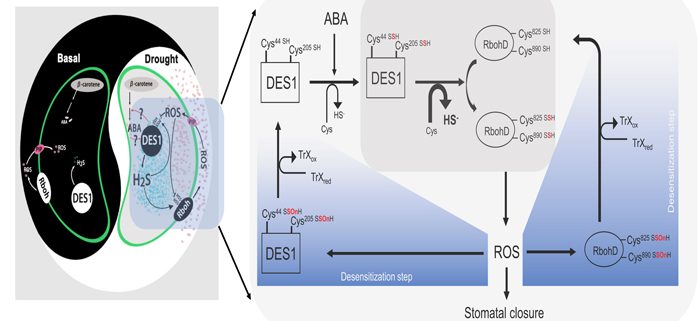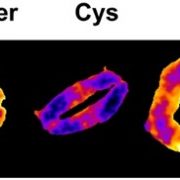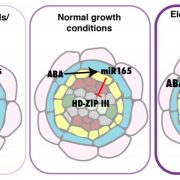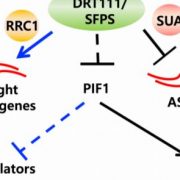Persulfidation-controlled guard cell ABA signaling
Shen et al. explore the role of H2S signaling and the reversible modification persulfidation in guard cell signaling. https://doi.org/10.1105/tpc.19.00826
Yanjie Xie; Laboratory Center of Life Sciences, College of Life Sciences, Nanjing Agricultural University, Nanjing 210095, PR China.
Background: In guard cells, several bio-active molecules involved in abscisic acid (ABA)-dependent signaling cascades have been identified, such as nitric oxide and reactive oxygen species (ROS), and new members are still emerging. Recent evidence has demonstrated that hydrogen sulfide (H2S) produced through the activity of L-cysteine desulfhydrase (DES1) is an important gaseous signaling molecule in guard cells that could participate in (ABA)-induced stomatal closure. Signaling by H2S is proposed to occur via persulfidation, a redox-based post-translational modification of protein cysteine residues (R-SHs) by covalently adding to the thiol groups to form persulfides (R-SSHs), which could regulate diverse physiological and pathological processes, and thus providing a framework for understanding the physiological effects of H2S.
Question: How protein persulfidation acts as a specific, reversible signaling sensor in plants remains poorly understood. We wanted to know how DES1 was activated, and whether its persulfidation could fine-tune guard cell redox homeostasis and ABA signaling.
Findings: DES1 activation is analogous to auto-phosphorylation of kinases. In the presence of ABA, DES1 itself was activated by H2S through auto-persulfidation at Cys44 and Cys205, and this led to transient H2S overproduction in Arabidopsis guard cells. Sustained H2S accumulation triggers persulfidation of the NADPH oxidase respiratory burst oxidase homolog protein D (RBOHD) at Cys825 and Cys890, which enhances its ROS-production ability and is physiologically relevant to ABA-induced stomatal closure. Over-accumulated ROS further leads to the persulfidation oxidation, thus demonstrating a negative feedback loop that fine-tunes guard cell redox homeostasis and prevents ABA signaling in guard cells from being continuously on.
Next steps: Currently, we are working to determine how protein persulfidation and persulfidation oxidation act as specific, reversible signaling sensors in plant responses to changing environmental conditions, and to understand the underlying mechanisms at the cellular and molecular levels.
Jie Shen, Jing Zhang, Mingjian Zhou, Heng Zhou, Beimi Cui, Cecilia Gotor, Luis C. Romero, Ling Fu, Jing Yang, Christine Helen Foyer, Qiaona Pan, Wenbiao Shen, Yanjie Xie (2020) Persulfidation-based Modification of Cysteine Desulfhydrase and the NADPH Oxidase RBOHD Controls Guard Cell Abscisic Acid Signaling. Plant Cell https://doi.org/10.1105/tpc.19.00826










